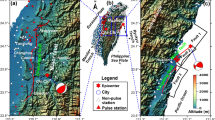Abstract
There are many reports about the research on near-fault velocity pulses, which focus on the generation of velocity pulse and simplify the velocity pulse so as to be used in the seismic design of structure. However few researches have put emphasis on the characteristics of near-fault ground motions containing velocity pulses, especially the characteristics relevant with the design response spectrum prescribed by the code. Through collection of a large number of near-fault records containing velocity pulses, the response spectra and the characteristic periods of records containing no pulses are compared with those of records containing pulses. Response spectra of near-fault records are compared with standard spectra given by code; furthermore, the response spectra and the characteristic periods of each earthquake are compared with that given by code. The result shows that at long periods (longer than 1.5 s), the response spectrum of pulse-containing records is bigger than the response spectrum of no-pulse-containing records; when the characteristic period of near-fault records is calculated, the method that does not fix frequency is more reasonable because the T 1 and T 2 have a lagging tendency; regardless of the site I and site II, the characteristic period of pulse-containing records is over twice bigger than the characteristic period given by the code.
Similar content being viewed by others
References
Alavi B and Krawinkler H. 2000. Consideration of near-fault motion effects in seismic design [A]//Proceedings of 12th World Conference on Earthquake Engineering [C]. Auckland, New Zealand: The New Zealand Society for Earthquake Engineering. No. 2665.
Bertero V. 1976. Establishment of design earthquakes evaluation of present methods [J]. Symp Earthquake Structural Engg, 1: 551–580.
Bouchon M, Bouin M, Karabulut H, et al. 2001. How fast is rupture during an earthquake? New insights from the 1999 Turkey earthquake [J]. Geophys Res Lett, 28(14): 2 723–2 726.
Hall J F, Heaton T H, Halling M W, et al. 1995. Near-source ground motion and its effects on flexible buildings [J]. Earthquake Spectra, 11(4): 569–605.
HU Yu-xian. 1988. Earthquake Engineering. [M]. Beijing: Seismological Press, 155 (in Chinese).
HU Yu-xian. 2001. Explanation to the Zonation Map of China Earthquake Ground Motion Parameters [M]. Beijing: China Standard Press, 86–87 (in Chinese).
Kawase H and Aki K. 1990. Topography effect at the critical SV-wave incidence: possible explanation of damage pattern by the Whittier Narrows, California, earthquake of 1 October 1987 [J]. Bull Seism Soc Amer, 80: 1–22.
LI Xin-le and ZHU Xi. 2003. Study on velocity pulse effect and its simulated model for near-fault ground motions [J]. China Safty Science Journal, 13(12): 48–52 (in Chinese).
LI Xin-le and ZHU Xi. 2004. Study on equivalent velocity pulse of near-fault ground motions [J]. Acta Seismologica Sinica, 17(6): 697–706 (in Chinese).
Mavroeidis G P, Dong G, Papageorigiou A S. 2004. Near-fault ground motions, and the response of elastic and inelastic single-degree-of-freedom (SDOF) systems [J]. Earthquake Engng Struct Dyn, 33: 1 023–1 049.
Oglesby D and Archuleta R. 1997. A faulting model for the 1992 Petrolia earthquake: Can extreme ground acceleration be a source effect? [J]. J Geophys Res, 102(B6): 11 877–11 897.
Orozco G L and Ashford S A. 2002. Effects of large velocity pulses on reinforced concrete bridge columns [A]. Pacific Earthquake Engineering Research Center Report [R]. Berkeley: University of California, 23: 10–12.
Sasani M and Bertero V. 2000. Importance of severe pulse-type ground motion in performance-based engineering: Historical and critical review [A]//Proceedings of 12th World Conference on Earthquake Engineering [C]. Auckland, New Zealand: The New Zealand Society for Earthquake Engineering. No. 1302.
Somerville P and Graves R. 1993. Conditions that give rise to unusually large long period ground motions [J]. The Structural Design of Tall Buildings, 2: 211–232.
Somerville P G. 1998. Development of an improved ground motion representation for near fault ground motion [A]. Seminar on Utilization of Strong-motion Data Oakland CA [C]. California: Oakland, 1–20.
State Standard of People’s Republic of China. 2001. Code for Seismic Design of Buildings [M]. Beijing: China Construction Industry Press, 17–18 (in Chinese).
WANG Jing-zhe and ZHU Xi. 2003. Acceleration-sensitive region under pulsation ground motion near seismic source [J]. China Railway Science, 24(6): 27–30 (in Chinese).
WU Xin and ZHU Xi. 2003. Effect of velocity pulse in near field ground motions and certification of regression equations to simple impact [J]. Journal of Northern Jiaotong University, 27(1): 36–39 (in Chinese).
ZHOU Xi-yuan, WANG Guo-quan, YANG Run-lin, et al. 2001. The peak acceleration attenuation law at different kinds of sites in 1999 Taiwan Chi-Chi earthquake [A]. Research Reports on the Key Issues and Design Theory of Large Complex Structures [R]. Dalian: Dalian Technology University Press, 406–413 (in Chinese).
ZHOU Yong-nian and YU Hai-ying. 2001. Features of long-period response spectra of accelerograms from Chi-Chi earthquake [A]. Research Reports on the Key Issues and Design Theory of Large Complex Structures [R]. Dalian: Dalian Technology University Press, 25–31 (in Chinese).
Author information
Authors and Affiliations
Corresponding author
Additional information
Foundation item: National Natural Science Foundation of China (50278090).
Contribution No. 06FE3027, Institute of Geophysics, China Earthquake Administration.
About this article
Cite this article
Wei, T., Zhao, Fx. & Zhang, Ys. Characteristics of near-fault ground motion containing velocity pulses. Acta Seimol. Sin. 19, 677–686 (2006). https://doi.org/10.1007/s11589-006-0677-0
Received:
Accepted:
Issue Date:
DOI: https://doi.org/10.1007/s11589-006-0677-0




